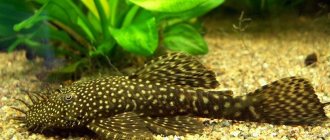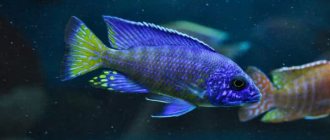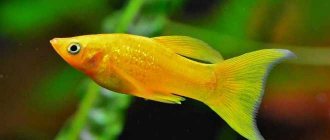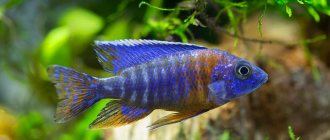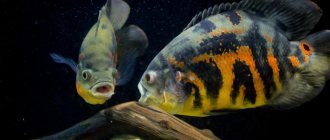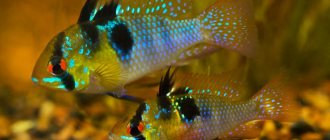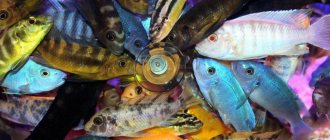Queen Nyasa description
Order, family: cichlids or cichlids.
Comfortable water temperature: 22-30 C
Ph: 7,2-8,5.
Aggressiveness: fairly aggressive 50%
Compatibility of Queen Nyasa: similar cichls, catfish.
Description:
Homeland - lake Malawi.
The body is elongated, with a high back, flattened laterally. The head is large, angular, with two rows of depressions visible on it, running from the corner of the mouth around the eye to the upper edge of the gill cover. The dorsal fin is long. Length up to 18 cm.
Males have a shiny violet-blue head and blue lips. The color of the front of the body varies from reddish-yellow to dark red, which gradually turns into green-blue on the back of the body. When irritated, 9-10 transverse dark stripes appear on the side. The back is olive green. The unpaired fins are blue, sometimes black towards the edges. Dorsal fin with a light blue border. There are several reddish spots on the anal fin. The paired fins are reddish, with a blue-white border in front.
The female has a gray-violet color with a silvery sheen and dark transverse stripes of variable intensity. The fins are body-colored, transparent, there are light blue spots on the dorsal and caudal fins, the dorsal fin has a light blue border.
Pisces, calm and relatively peaceful towards other species. The aquarium should have shelters, as well as flat stones, caves and grottoes, and possibly plants.
Comfortable water parameters for keeping a Nyasa queen: 22-30°C, dH 4-20°, pH 7.2-8.5. Aquarium size from 150 liters. Aeration and filtration
required.
Queen Nyasa photo
Description
Orchids' body shape and behavior are characteristic of cichlids. Aggression is rarely shown: usually males during the spawning period towards males of their own species.
Appearance
The body of the fish is elliptical, elongated towards the base of the tail, flattened laterally. The head is pointed, the mouth is large, directed straight. The color of the body and fins of the male is red-orange with white and neon blue-blue spots. The dorsal and anal fins are elongated to the base of the tail. The caudal fin is trapezoidal. Body length - 12–15 cm.
Females are 1.5–2 cm smaller. Color: pink or colorless with dark transverse stripes.
Character
Aulonocara orchids love to swim in the bottom and middle layers of water. They go upstairs to eat. Active during the day.
Males are territorial. Not aggressive when there are too many females. Fry and small fish are considered prey. Shelters are required (grottoes, snags, thickets of plants).
If there is a lack of plant food, plant foliage is plucked on fasting days. They dig up roots in sandy soil. They eat snails.
Lifespan
They live 8–10 years.
Diseases
Diseases in Aulonocara nyasa often occur due to a decrease in the immune system. This can happen as a result of a lack of nutrients and vitamins, hypothermia, or poor quality care.
Various infectious diseases often occur in fish:
- White-skinned. With this disease, a change in appearance occurs - the color of the skin becomes lighter or white. Patients should be separately transplanted into a container of water to which chloramphenicol is added;
- Fin rot. There is damage to the fins due to poor water quality or due to attack by other fish. The fins become deformed and decrease in size. To cure the fish, it is necessary to replace the water in the aquarium; it is better to place them in a solution of chloramphenicol;
- Neon disease. During this, the fish rise to the surface, their movements become spasmodic, they take a position upside down. It cannot be treated; infected individuals must be destroyed.
These are not all the diseases that Aulonocara owners may encounter. If they are maintained correctly, many of them can be avoided.
It is important to provide high-quality food containing vitamins and minerals that can improve the fish’s immunity.
Aulonocara nyasa are interesting fish that are often kept in the home aquarium. They have a playful and peaceful nature, so they can be kept with any type of aquatic species. But in order for them to feel good and be healthy, it is necessary to follow important rules for keeping them in the aquarium.
Kinds
Most aquarium species of aulonocara are obtained by breeders. They differ in size and coloring. The conditions of keeping and breeding are the same. Males are described because of their striking exterior.
Orchid ed
Aulonocara orchid red (strawberry) - the same as Aulonocara Orchid.
Multicolor
Grows up to 12–15 cm. The color is bright orange with purple and dark gray spots.
Nyasa
Aulonocara nyassae or Queen of Nyassa. It grows to sizes of 15–17 cm. The color of the body and fins is blue-violet, fluorescent. Anal fin with light spots. Found in natural conditions.
Bensha
She is also the golden queen (Aulonocara baenschi). Grows up to 10–12 cm. The color of the body and fins is golden-yellow with blue-blue stripes and spots.
Red flush
Grows up to 12–15 cm. The color of the body and fins is blue-violet with dark stripes. The skin behind the gills and pectoral fins are orange-red.
Aurika
Aulonocara Eureka grows to 9–12 cm. The body and pectoral fins are yellow with dark gray stripes. The head and other fins are blue-violet with dark spots.
Rose
Aulonocara rose grows up to 13–15 cm. The color is pink with a yellow tint.
Red ruby
Aulonocara Red Rubin grows to 12–15 cm. The color is orange-red with a neon blue head, stripes and edging of the dorsal fin.
Red Dragon
It is also known as “aulonocara strawberry” or “fire fish”. Grows up to 12–15 cm. The color is orange-red with white, bluish spots.
Freiberg
Grows up to 15–17 cm. The color of the body and fins is red-orange. The jaws are violet-blue. On the sides there are purple and dark gray transverse stripes. The dorsal and caudal fins have a light border. Caudal fin with a semicircular notch at the end.
Features and habitat of Aulonocara
The most common color for males is bright blue. The fin has a clearly defined white edge on its back. There are ruby, yellow and albinos. On the sides of these fish, transverse stripes of dark tones are clearly visible. They are more noticeable among representatives of the fair sex. Their color is brown with olive tones.
Most often, this beauty can be found in nature on the territory of silted sediments or underwater rocks of Lake Malawi. They feel comfortable at great depths, in complete darkness. In such conditions it is very easy for them to hunt and hide from potential enemies. After all, the bottom of reservoirs is full of various predators and dangers. These are painfully peaceful creatures.
In a 150 ml aquarium, aulonocara can perfectly coexist with other species of fish, the main thing is that they are not aggressive. On the lateral line of these fish, which is their main organ, there are interesting neuromast cells, thanks to which they sense the slightest vibrations on the surface.
The fish also feel all changes, even the smallest ones, in water pressure thanks to the enlarged pores on the front part of their skull. The main food product of aulonocara in nature are insects and their larvae, which are mainly found on the sandy bottom.
That is why the fish stay close to him. Hunting for invertebrates is the favorite pastime of fish in nature. It's interesting to watch this. Aulonocara can hover motionless in the water for a long time near the habitat of its prey.
As soon as there is movement in the sand, the fish grabs the prey along with the sand and sifts it with the help of its gills. The fish immediately swallows the caught insect. The aquarium has a slightly different environment, a different world. Therefore, it is almost impossible to observe Aulonocara hunting. But you can observe the fish trying to find something in the sand.
Content
They are kept in harems if the capacity of the aquarium allows. Be sure to have plenty of shelter from plants, stones, and snags. Orchids love clean water with a weak current: provide filtration and aeration.
The fish are suitable for crossing and selection. Typically, species are bred by specialists. Uncontrolled cross-breeding leads to damage to the exterior and degradation of the breed. Therefore, keeping different species of aulonocara together is not recommended.
View this post on Instagram
Posted by Lidiya (@lidiya.skopina) Nov 24, 2021 at 12:08 PST
To maintain stable water parameters, change 1/3 of the water weekly. Use a siphon to remove food debris and excrement from the bottom.
Aquarium
Orchids live closer to the bottom. Therefore, choose a rectangular aquarium with an aspect ratio (WxHxD) of 2 x 0.5 x 0.5. For a flock of 4 fish you will need a species aquarium of 150 liters or more.
Water parameters
- Ambient temperature: 24–28 °C.
- Acidity: pH 7–8.5.
- Hardness: 1.5–9 °F.
Plants
Considering the tendency of aulonocara orchids to dig up roots, place plants with a developed root system in the aquarium.
- Anubias.
- Cryptocoryne.
- Vallisneria.
If you use ground covers (Echinodorus), leave a clear area from plants for spawn marking. Floating in the water column:
- Java moss;
- elodea.
Floating on the surface:
- riccia;
- salvinia.
Priming
Suitable as in natural conditions:
- sandy substrate;
- rounded pebbles 5–8 mm.
Equipment
- Compressor with 1–2 nozzles. Productivity: 1 liter of air per hour per 1 liter of capacity.
- For jars over 150 liters, choose an external canister filter. Capacity: 7–8 vessel volumes per hour.
- Heater with thermostat.
- Siphon for removing bottom contaminants.
- Scraper for removing algae from glass containers.
- Net with frame 8".
Lighting
The backlight is diffused, standard. Luminous flux 50–60 lumens per liter of water. Daylight hours are 8–10 hours.
Use energy-saving fluorescent and LED lamps with a color temperature of 7500 K. LED sources have twice the light output (lm/W).
Scenery
The decorations are also used as shelters for orchids. Should not have sharp elements. Damaged fish skin is easily affected by fungal diseases.
- Driftwood made from non-coniferous wood. Oak ones are also not suitable: they stain the water. Boil the driftwood, peeled from bark, in 4–5 batches for 1–1.5 hours each, changing the water. Soak with daily water changes until it stops staining.
- Choose massive stones with a flat side. Or use pads to distribute the load on the glass.
- Craftsmen make grottoes themselves from stones and clay. When gluing elements, use aquarium sealant to avoid poisoning the inhabitants.
- Ceramic and glass rings.
- Bright aulonocara orchids look advantageous against the dark background of the back surface.
The scenery can be brought to life. Secure mosses and lichens to the surface using fishing line. Over time, the plants will gain a foothold and the decorations will grow.
Compatibility
As noted earlier, Malawian cichlids are territorial fish, so the problem of cohabitation and the correct selection of neighbors is quite acute.
The best option for keeping representatives of one species would be a “harem” - when there are two or three females for one male. If the volume of the aquarium allows, several groups can be placed together, but the females should predominate in any case. You will also need shelters so that the fish can hide from each other if necessary.
Malawian cichlids in a community aquarium
The best neighbors for a community aquarium will be other species of Malawian cichlids that are similar in size. In this case, females should predominate. It is better to raise fish together from a young age, then the cichlids are calmer towards each other. Malawians get along well with large catfish - pterygoplichts or plecostomus. There have been cases of successful cohabitation with large barbs.
Malawians also get along well with relatives from the neighboring country.
Malawian and American cichlids are often combined in the same aquarium. Unfortunately, such cohabitation will not be the best choice due to the difference in water parameters and feeding methods.
What to feed
Aulonocara orchids are omnivorous. Animal food predominates in the diet. Plant food makes up 20–30%.
Live food
- Bloodworm is a mosquito larva. High-calorie, hemoglobin-rich, vitamin food.
- Koretra is a mosquito larva. Mobile dietary food. Forces fish to hunt.
- The tubifex is an annelid worm. Recommended for weakened and growing fish.
Do not purchase live food from unverified sellers. Fish caught in natural waters may be infected with infection, parasites, and contain harmful substances. The coretra is not so dangerous, since it lives and obtains food in the water column.
Frozen food
Fully preserves the usefulness of the living. It is not a carrier of parasitic and bacterial threats. But re-frozen is unsuitable for use. And this is impossible to control.
Dry food
They are not suitable for constant feeding: orchids lose color and stop reproducing. Helpful if you plan to be away for a long time. Use automatic feeders with a timer.
Goldfish coloring granules maintain color intensity. Ask 1-2 times a week.
Plant food
Purchased - tablets with spirulina. Dried and fresh herbs, nettle and dandelion leaves are suitable. Blanched zucchini, pumpkin, and cabbage are useful. From cereals - crushed oat flakes (“Hercules”).
Prepared feed
For high-quality color, aulonocara orchids require sufficient quantities of carotenoids (astaxanthin). It is found in significant quantities in red fish, carrots, and other red vegetables and fruits. Prepare and freeze minced meat containing the specified components with the addition of shrimp, squid, and mussels. Astaxanthin is also an antioxidant and improves metabolism and digestion.
Diet
Feed 2 times a day. 1-2 days a week - fasting. Do not overfeed: orchids are prone to obesity. The norm is the amount of food eaten in 2 minutes.
Reproduction
With recommended maintenance parameters, it takes place in a general aquarium. If breeding is intended, remove the female Aulonocara orchid with fertilized eggs.
Sex differences
Sexual dimorphism appears after puberty (9–12 months in females, males 1.5–3 months later). Males are brightly and variedly colored (after 1.5 years), the anal and caudal fins are pointed. Behavior is dominant. Females have a monotonous color with dark transverse stripes. The photo shows a female.
Spawning
After courtship and games, the female lays eggs (20–60 eggs). Typically tagging occurs at night. The eggs ripen in the female’s mouth within 17–20 days. During the incubation period, the female does not consume food.
The hatched fry periodically return to the female's mouth. On the 3rd day, place the female in a common aquarium. Starter food for fry is “live dust”, nauplii and zooplankton (“blooming” water). Feed 5-6 times a day. Protein supplement: boiled chicken egg yolk, strained through a fine mesh net. Don’t be afraid to overfeed: growing organisms do not get fat.
Breeding
At the age of one year, cichlids become sexually mature. They spawn in a community aquarium, and the aquarist does not need to do anything. The male digs a hole and prepares a place for spawning. The female, ready for spawning, swims up to the hole and lays 15-80 eggs, which she collects in her mouth along with the male’s milk. Fertilization of eggs occurs in the mouth. For 2-3 weeks, while the eggs are developing, the female does not eat anything.
The young are strong and voracious. They feed her with artemia nauplii, cyclops and dry food ground into dust. At the slightest danger, the grown fry hide in their mother’s mouth.
Reviews
Aquarists note the decorative qualities of Aulonocara orchid and its compatibility with peaceful fish. Easy to maintain.
Disadvantages include the bright exterior of only males and attacks on small fish and veiltails. They are prone to eating and digging up plants.
Fish diseases
The main cause of diseases lies in the conditions of detention; if they go beyond the acceptable range, then immunity is inevitably suppressed and the fish becomes susceptible to various infections that are inevitably present in the environment. If you first suspect that the fish is sick, the first thing you need to do is check the water parameters and the presence of dangerous concentrations of nitrogen cycle products. Restoring normal/appropriate conditions often promotes cure. However, in some cases it is impossible to do without drug treatment.
In general, the fish is well suited for both experienced aquarists and those who have just decided to try keeping African cichlids. They are easy to care for, easy to feed, they are quite unpretentious. In addition, they are distinguished by a calm disposition, which makes them desirable fish in general cichlids.
